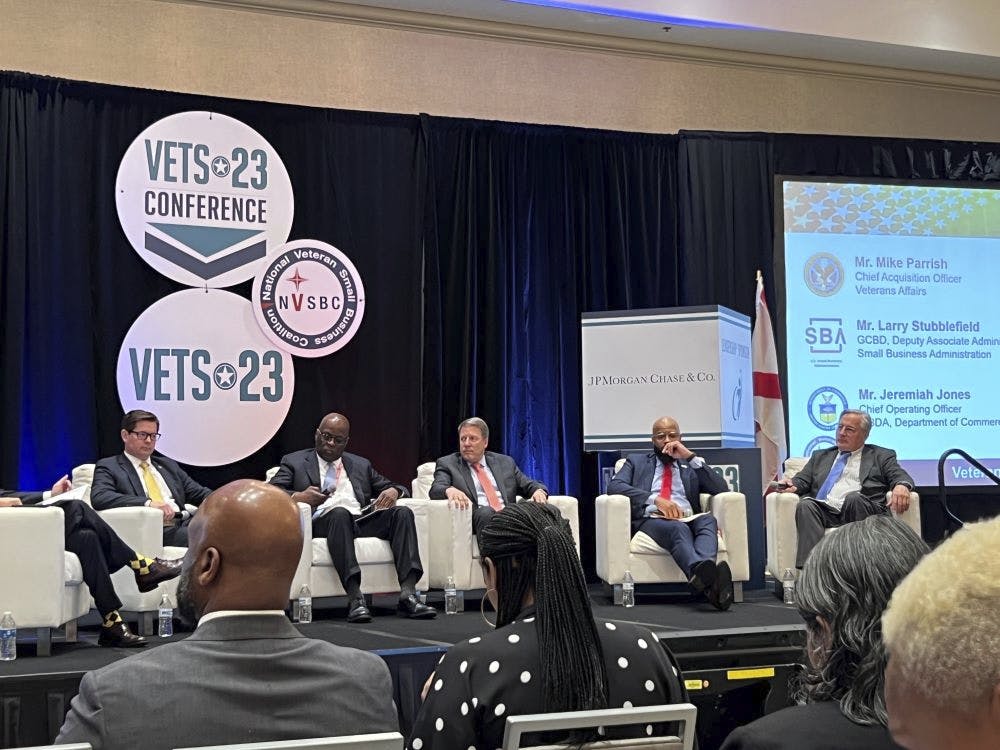How Government Contracting Heads Plan to Elevate Small Businesses
Federal acquisition leaders outline top goals and priorities for upcoming government contracts during the VETS23 conference in Orlando, Florida.

Leaders across government are laser focused on simplifying the federal acquisition process to bring in more small businesses and promote more equitable contracting opportunities.
Since 2010, agencies have seen a 40% decrease in the number of small businesses receiving prime contract awards, and the number of small businesses doing business with government has decreased by about 60%.
“What we see is a few doing very well, meaning if you have a pond, and there are fish in there, we have limited fish. We want to increase the number of fish in the pond,” Phillip Christy, Department of Veterans Affairs deputy chief acquisition officer said during the VETS23 conference in Orlando, Florida Tuesday.
To improve these trends, federal agencies including the Small Business Administration (SBA), VA and General Services Administration (GSA) are exploring ways to bring in new business from smaller companies.
Capital and relationships move the needle
“Capital is king,” SBA Administrator Isabella Casillas Guzman said at VETS23. “There’s been also gaps in venture capital and early-stage funding that we need for frontier technologies, which is critical for the warfighter. And so, we’ve looked, in the Biden-Harris Administration, to transform on capital access.”
VA aims to increase exposure, communication and relationships to bring in more small businesses and drive transparency. The agency recently created a new pathfinder tool, https://pathfinder.va.gov/, which serves as a single-entry point for innovation and selling. The site helps both large and small businesses navigate certifications.
“It’s an easy to use intelligent, integrated system that helps our industry partners to be able to sell to the VA and it’s being propagated across government,” Michael Parrish, VA’s chief acquisition officer, said at VETS23.
The federal government saw $72 billion in IT expenditures last year, according to Larry Hale, GSA’s deputy assistant commissioner for Category Management. As government awards contracts, leaders want to ensure equal access to and equity within contracting opportunities.
“We want to help get more companies onto our contracts, get them the opportunities,” Hale said at VETS23.
Technology facilitates equity
To help small businesses and improve equity for rural, veteran-, women- and minority-owned businesses, the SBA developed new tools to simplify processes and streamline capital to businesses. The agency is also in the process of expanding its distribution network by modernizing its loan programs.
“The Defense Department and SBA partnered late last year. … They’re going to be leveraging the SPLC program and this is another area that we’re in the process of reforming,” Guzman said. “We are focused on underserved communities. We’re going to come up with a new type of Small Business Investment Company (SBIC) – we call it a rural SBIC – that’ll allow for up to two years of deferred payments on the interest in principle or until an exit. This really allows for more venture, for more growth within the portfolio.”
The SBA also successfully deployed the Veteran Small Business Certification (VetCert) and finalized more than 4,000 businesses through this program, Guzman said. The certification process takes an average of 24 days and SBA plans to replicate this model across the agency certification programs.
“We’re also introducing MySBA, which is going to be a single point of entrance, so that you can come in and leverage the data that we put in across our program portfolio, but VetCert is the lead on that platform, and we’re going to come out with a VetCert 2.0, but there’s obviously continuous improvement that we have to deploy,” Guzman said.
To continue to support businesses and improve customer experience, the SBA is investing in technology and leveraging partnerships to simplify processes and become more customer-centric.
“We have to leverage partnerships, whether that’s working more closely with our lender networks to ensure capital readiness, investing in technologies and investing in customer service… I do think it’s about expanding to build trust in communities that have been historically underserved,” Guzman said.
This is a carousel with manually rotating slides. Use Next and Previous buttons to navigate or jump to a slide with the slide dots
-

Feds Turn to DevSecOps to Balance Innovation with Public Trust
Officials embrace DevSecOps and a human-centered approach to modernize operations and manage risk as AI becomes more embedded in government.
4m read -

VBA Uses Automation to Tackle Claims Surge, Augment Workforce
VBA leverages automation and AI to streamline claims processing and reduce backlogs, while keeping humans central to the process.
4m read -

Doing More with Less is Muscle Memory for IRS, Former Deputy CIO Says
Darnita Trower discusses her experience, the legacy she’s left behind and how she pushed the IRS to modernize itself,
20m watch -

The Next AI Wave Requires Stronger Cyber Defenses, Data Management
IT officials warn of new vulnerabilities posed by AI as agencies continue to leverage the tech to boost operational efficiency.
5m read








